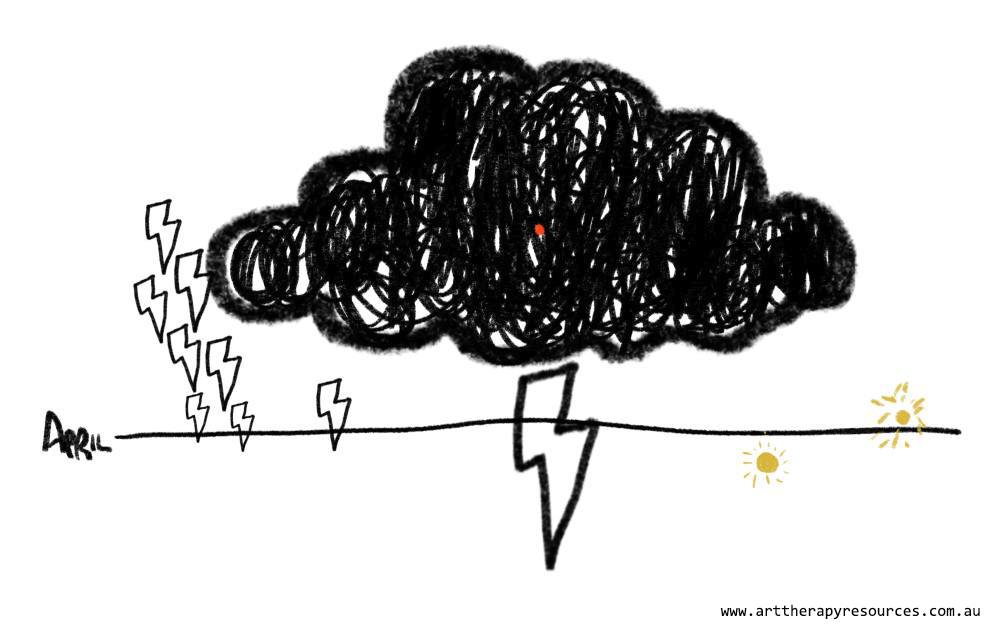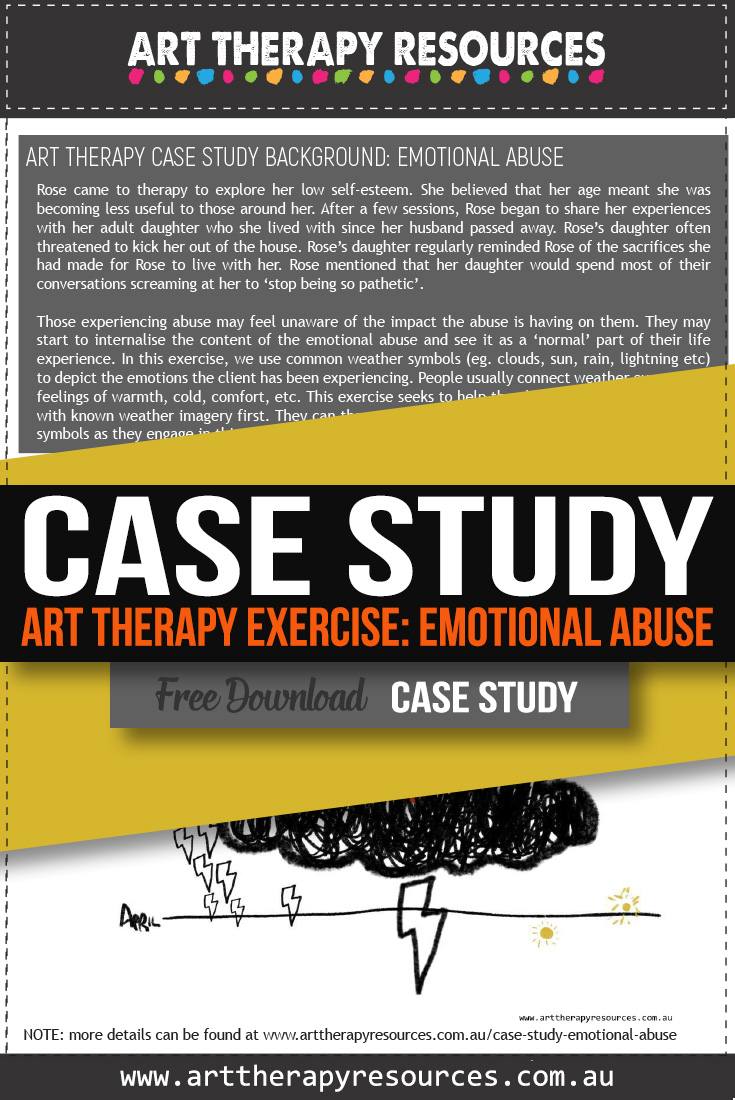THIS POST INCLUDES:
- Art Therapy and Emotional Abuse
- About the Client
- Art Therapy Exercise
- Client Insight and Outcomes
- Disclaimer
- FREE DOWNLOAD Art Therapy Exercise
ART THERAPY AND EMOTIONAL ABUSE
Emotional abuse is often interchangeable with psychological abuse and refers to the emotional mistreatment of a person. This emotional mistreatment diminishes and destroys the inner self of the individual as their ideas, feelings, perceptions, and character is eroded. As the individual’s self-belief is eroded, the abuser takes advantage of this power imbalance and increases the abuse.
Emotional abuse often does not carry any outward signs of abuse such as physical abuse. This means it can be difficult for the victim and others to identify that abuse is occurring. The effects of abuse are often dismissed or not acknowledged at all. Excuses are made for the abuser who uses manipulation to ensure the victim internalises the blame for the abuse.
Emotional abuse can take many forms including overt behaviour such as humiliation and threats. However, it can also include covert behaviour such as ignoring, isolation, and vicarious abuse through exposure to more overt behaviour against other individuals.
Those who experience emotional abuse from an individual often experience multiple types of abuse, although the abuser may conduct a specific set of behaviours. Some emotional abuse is so subtle that it may be difficult for people to recognise the behaviour as abusive. They may dismiss it as irregular, an unexpected outburst, or a consequence of the abuser going through a difficult time.
Some common emotional abuse behaviours include:
- Humiliation
- Intimidation
- Blaming
- Silent treatment
- Gaslighting
- Ridiculing
- Ignoring
- Controlling
- Manipulating
- Name calling
- Shaming
- Withholding intimacy/affection
- Accusing
- Unreasonable expectations
Anyone can experience emotional abuse, however, individuals can be at higher risk of emotional abuse if they are exposed to the below issues:
- Mental health problems
- Domestic abuse
- Drug or alcohol addiction
- Family disputes
- Unemployment
- Financial distress
- Immigration (due to isolation from social supports)
- Poverty
Emotional abuse can also occur in a variety of situations including:
- Home (includes foster homes, nursing homes etc)
- School
- Clubs (sports, theatre etc)
- Work
The impact of emotional abuse can be significant. Because the abuse is not visible and is often hidden under the guise of relationship struggles, the abuse can occur over a long period of time which increasingly affects the victim.
Common effects of emotional abuse are:
- Codependency
- Trauma bonding
- Isolation from other support networks (family/friends)
- Depression
- Anxiety
- PTSD
- insomnia
- Physical tension and chronic pain
- Hypervigilance
- Performance issues at school, work etc
- Self-harm
- Obsessive thoughts and behaviours
HOW ART THERAPY CAN HELP WITH EMOTIONAL ABUSE
Research by Rachel Goldsmith and Jennifer Freyd (Awareness for Emotional Abuse) states that:
“Emotional abuse and neglect were significantly positively correlated with difficulty identifying feelings, even after controlling for participants’ depression, anxiety, dissociation, and lifetime trauma. Few subjects self-identified as having been “abused,” even among those reporting abuse experiences. The results demonstrate a connection between emotional abuse and difficulty identifying emotions”.
Art therapy can play an integral part in providing space for the individual to explore different aspects of their relationships and work towards identifying the function of those relationships. This can lead to the individual developing an awareness of how relationships in their lives impact their overall wellbeing. When the individual can begin to acknowledge the impact of these relationships, they can also identify important emotions associated with the dynamics of those relationships.
Art therapy can play an important part in helping those who have suffered from emotional abuse. Those who suffer from emotional abuse can feel depleted of personal autonomy if they have experienced repeated humiliation, control, and ridicule. They may feel controlled by an abuser and believe they cannot speak about their experiences.
Art therapy is especially beneficial for children because emotional abuse is often a confusing concept when children implicitly trust their primary care-giver.
Some of the most important areas where art therapy can help people who have experienced abuse include:
- diffusing negative thoughts
- redirecting
- reframing
- self-soothing
- emotional expression
- emotional regulation
- coping with overwhelming emotions
- explore personal value
- explore resilience
Art therapy provides the client with a space to explore all facets of their experience. The therapist can help the client unfold the impact of the emotional abuse so they can begin to reestablish the foundation of their emotions, perceptions, and personality characteristics.
Over time the client and therapist can establish goals to validate the client’s experience and seek to reintegrate all parts of the client to become whole where the emotional abuse had once caused fractures within the inner self.
Clients can use art therapy to explore the signs of emotional abuse and the impact the abusive behaviours has on the client. Art making can be used to help the client identify these important aspects of the abuse cycle so they can develop insight for further interactions.
Helping the client to develop an awareness of the abuse as well as the detrimental impact of the abuse, can help the client stop internalising the abuse as deserved.
While we know that emotional abuse is mostly invisible, art therapy can provide a visible aspect for the client to reflect on when working towards insight and future change.
The act of creating art can provide clients with a sense of purpose, achievement, and personal ownership over their artwork. This can cumulatively build upon other self-esteem building techniques that will benefit the client over the long term.
ABOUT THE CLIENT
- Name: Rose
- Age: 67
CURRENT CLIENT ISSUES:
Rose came to therapy to explore her low self-esteem. She believed that her age meant she was becoming less useful to those around her. After a few sessions, Rose began to share her experiences with her adult daughter who she lived with since her husband passed away.
Rose’s daughter often threatened to kick her out of the house. Rose’s daughter regularly reminded Rose of the sacrifices she had made for Rose to live with her. Rose mentioned that her daughter would spend most of their conversations screaming at her to ‘stop being so pathetic’.
ART THERAPY EXERCISE
Those experiencing abuse may feel unaware of the impact the abuse is having on them. They may start to internalise the content of the emotional abuse and see it as a ‘normal’ part of their life experience.
In this exercise, we use common weather symbols (eg. clouds, sun, rain, lightning etc) to depict the emotions the client has been experiencing. People usually connect weather events with feelings of warmth, cold, comfort, etc.
This exercise seeks to help the client identify those feelings with known weather imagery first. They can then move on to identifying other emotions with other symbols as they engage in this exercise.
INSTRUCTIONS:
- Ask your client to draw a timeline to represent a typical week or month in their life.
- Discuss with your client the use of common weather symbols to represent emotions the client may be experiencing. Typical symbols used might be sunshine, clouds, rain, lightning etc.
- Ask your client to use these symbols to draw a visual representation of their interactions with the person in their life that they are experiencing difficulties with.
- Discuss with your client how they used the weather symbols to reflect their feelings.
- Discuss with your client if they notice any patterns of feelings amongst the interactions.
- Ask your client whether they would like to draw any further ‘weather timelines’ to explore any other feelings about these interactions.
CLIENT INSIGHT AND OUTCOMES
Rose initially felt intimidated by the drawing exercise as she wasn’t confident with drawing. However, Rose felt confident that she could draw weather symbols and liked connecting these shapes with her emotions. Rose realised that most of her symbols represented dark and stormy feelings. These symbols represented the chaotic nature of her relationship with her daughter. Rose noted that she was so caught up in the interactions with her daughter that she didn’t realise how badly it was affecting her emotions.
Rose drew a large black cloud that covered the entire month. She also included a small red dot in the centre of the cloud. She felt this dot represented her love for her daughter. It was small and still visible but also consumed by the dark cloud.
Rose suggested she would like to continue using this art exercise to think about other interactions.

DISCLAIMER
This case study represents a snapshot of the client’s progress in treatment. The exercise in this article could be used as written or as a guide for new and original tasks developed by the Art Therapist. Responsibility for treatment resides with the individual therapist who understands their clients specific needs. The art therapy exercise should not be viewed as a pre-defined directive on how to treat a client that presents with a specific range of problems.This art therapy exercise will help build a database of knowledge to draw upon when helping your client. Art Therapy is associated with psychotherapy techniques, however each therapist often approaches therapy with their own foundation of psychological interventions, whether it be psychotherapy, CBT, DBT or other methods.
FREE DOWNLOAD: Art Therapy Exercise
Download the FREE Art Therapy Exercise based on the above Case Study. The free download includes instructions for the art therapy exercise, along with an example of the art therapy exercise.

BUILD YOUR ART THERAPY REFERENCE MATERIALS:
Pin this image to your Pinterest board.

SHARE KNOWLEDGE & PASS IT ON:
If you’ve enjoyed this post, please share it on Facebook, Twitter, Pinterest. Thank you!
